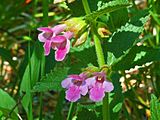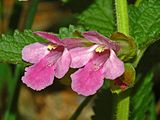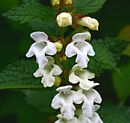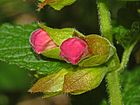- Melittis melissophyllum
-
Bastard Balm 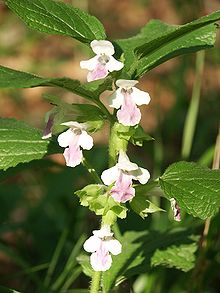
Scientific classification Kingdom: Plantae (unranked): Angiosperms (unranked): Eudicots (unranked): Asterids Order: Lamiales Family: Lamiaceae Genus: Melittis Species: M. melissophyllum Binomial name Melittis melissophyllum
L.Synonyms - Melittis sylvestrisLam.
- Melittis grandiflora Sm.
- Melittis carpatica Klokov
- Melittis subcordata Klokov
- Mellitis melissifolium Salisb
- Melittis albida Guss.
- Melittis graeca Klokov
- Melittis grandiflora'' Sm. (1799)
- Melittis hispanica Klokov
- Melittis kerneriana Klokov
- Melittis sarmatica Klokov
- Melissophyllum silvaticum St-Lager
- Rehmannia chinensis Libosch. ex Fish. & Mey.
Melittis melissophyllum, common name: the Bastard Balm, is a herbaceous perennial plant belonging to the genus Melittis of the Lamiaceae family. The name melittis of the genus derives from a Greek words Melissa or Melitta, meaning "honey bee" and refers to the properties of flowers of attracting these insects. The name melissophyllum of the species simply means "with leaves similar to melissa".
Contents
Description
Melittis melissophyllum reaches on average 30–50 centimetres (12–20 in) of height, with a minimum of 20 centimetres (7.9 in) and a maximum of 60 centimetres (24 in). It is a strongly aromatic plant with erect hairy stems. The root of this plant is a perennial short rhizome. This species is quite variable in shape of leaves and colors. The leaves reach 5–9 centimetres (2.0–3.5 in) of length. They are oval, bluntly-toothed, quite hairy. They have a short petiole and are in opposite pairs up the stems. The inflorescence is composed of large pedunculated hermaphrodite flowers (two to six, or more) growing in the axils of the leaves. The flowers are labiate, arranged in pairs and are one-sided (all flowers "look" at the same side). They are usually white or pale pink with a large pinkish purple blotch on the lower lip. They are mainly pollinated by bees and moths. The flowering period extends from May through August.
Gallery
Cultivars
"Bastard balm" is ideal for a sunny woodland edge or scrubby border, where it will be attractive to bees and other insects. It prefers moist, well-drained soils. There is a deep red garden cultivar called "Royal Velvet Distinction".
Distribution
It is found in central and southern Europe from southern England and West Wales as far east as Turkey.
Habitat
These plants prefer shady environment with mountain deciduous woods (oak, beech and chestnut), but also areas with , pines, hedges, shrubs and junipers. They usually occur on wood-edges and hedgebanks at an altitude of 0–1,400 metres (0–4,600 ft) above sea level.
Subspecies
- Melittis melissophyllum L. subsp. albida (Guss.) P.W. Ball (1971)
- Melittis melissophyllum L. subsp. carpatica (Klokov) P.W.Ball (1971)
- Melittis melissophyllum L. subsp. sarmatica Gladkova
- Melittis melissophyllum L. var. albida (Guss.) Nyman (1881)
- Melittis melissophyllum L. var. carpatica Soo & Borsos
- Melittis melissophyllum L. var. grandiflora (Sm.) Nyman (1881)
- Melittis melissophyllum L. var. melissophyllum
- Melittis melissophyllum L. var. kerneriana (Klokov) Soò et Borsos
- Melittis melissophyllum L. var. sarmatica Soo & Borsos
References
- Pignatti S. - Flora d'Italia - Edagricole – 1982 Vol. II, pg. 452
- Pink, A. - Gardening for the Million (2004) - Project Gutenberg|Project Gutenberg Literary Archive Foundation| isbn=1426457073 Gardening for the Million
- Klein Carol - How to grow Melittis melissophyllum - The Daily Telegraph - How to grow
- Canadian Food Inspection Agency: Plant Breeders' Rights Office: "Royal Velvet Distinction" - 30 Apr 2007 - Melittis melissophyllum
External links
 Media related to Melittis melissophylum at Wikimedia CommonsCategories:
Media related to Melittis melissophylum at Wikimedia CommonsCategories:- Lamiaceae
- Melittis melissophylum
- Flora of Europe
- Flora of Italy
- Lamiaceae stubs
Wikimedia Foundation. 2010.

